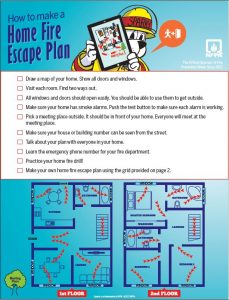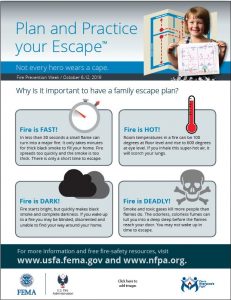What kind of educational programs are you and your department involved in within your community? Do you have structured plans to teach community members how to plan an escape? If escape planning is not a top priority for your department, it’s time to change that strategy.
According to the National Fire Protection Association,
- Seventy-one percent of households have a fire escape plan, but only 47% of those have practiced it.
- One-third believe they have at least six minutes before a fire in their home becomes life-threatening.
- Only 8% said their first thought was to get out when they heard the smoke alarm.
What we can gather from these statistics is that fire escape planning is on families’ minds, but they don’t understand the life-threatening nature of fire, heat and smoke- and that is a matter of life and death.
According to the FEMA, “Fire departments need to re-enforce these messages about the characteristics of fire: Fire is FAST. Fire is DARK. Fire is HOT. Fire is DEADLY!”
Our homes have changed – while we may have had 17 minutes to escape a home at one time, now we only have two. We need to create a sense of urgency in our community for fire escape planning using this information.
So, how do you get started with community outreach and education?
First thing is first – understand the trends and needs of your community. From FireRescue1: “You want to tailor the program to meet the specific and unique needs of your area. The only way to determine what your needs are is to identify and review local data. Start by reviewing your internal call data. What types of incidents do you respond to and which incidents do you respond to most frequently? The bottom line is that you need to identify what the local issues are and then devise a plan to correct those issues.”
Once you have some data on your calls and your community members, start brainstorming some solutions. “Remember, there are always multiple ways to achieve your goals, so don’t get tunnel vision on just one solution. Some solutions to fire prevention and public safety outreach may include standalone programs conducted through the fire department, a cooperative partnership with the local school district, and programs conducted in conjunction with local businesses or senior groups. Additionally, you could also coordinate and cooperate with other local emergency service agencies to create a regionalized program.” (FireRescue1.com)
Next, let’s talk about funding. Some programs may require larger amounts of funding than others. Many groups, like FEMA and the National Fire Protection Agency, have free resources that you can download right from their sites.
If free resources won’t be enough, you can ask for assistance from a local business – many would love to be partnered with their local fire departments. Or, you can apply for grants , such as through the Department of Homeland Security who has Fire Prevention and Safety grants.
Now it’s time to execute your plan. There are so many different ways to do this. A few ideas to get you started:
- Work with the local schools to plan something during Fire Prevention Week.
- Contact a local newspaper to discuss writing an article or publishing a press release.
- Ask HOA’s and neighborhood associations for a bit of time during their meetings to talk.
- Flood your email distribution lists with information.
- Partner with a local company like 1-800-BOARDUP to spread awareness in the community.
Finally, don’t forget to evaluate the program both during and after it’s over. If something can be changed right away, don’t hesitate to change tactics. Look at how the program can be expanded or more focused. And, most importantly, keep track of any data you can to improve the next time!
However you decide to implement your program, the important thing is that you HAVE a program. But, don’t rely on posters and fliers from ten years ago – they will not resonate in today’s world of communications. That’s why the research and data-mining at the beginning of your program is essential. Understand your market and how they want to be communicated to for the best results!
Visit usfa.fema.gov and nfpa.org for hundreds of resources to get you started!

Sources:
https://www.nfpa.org/Public-Education/Teaching-tools/Safety-tip-sheets

